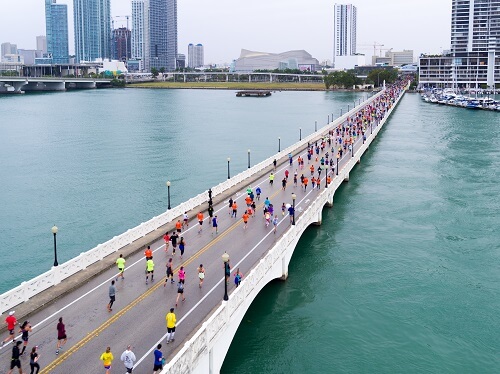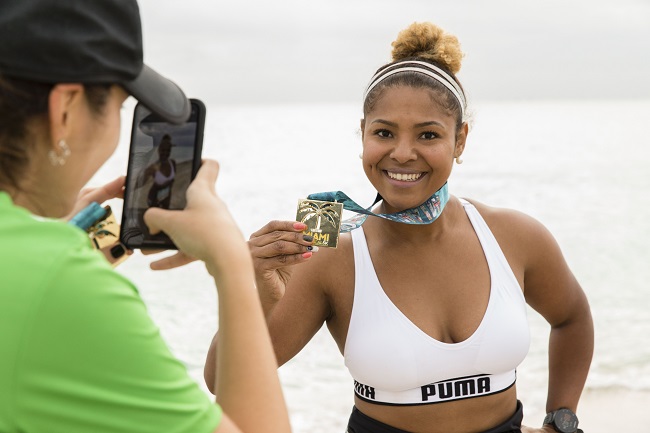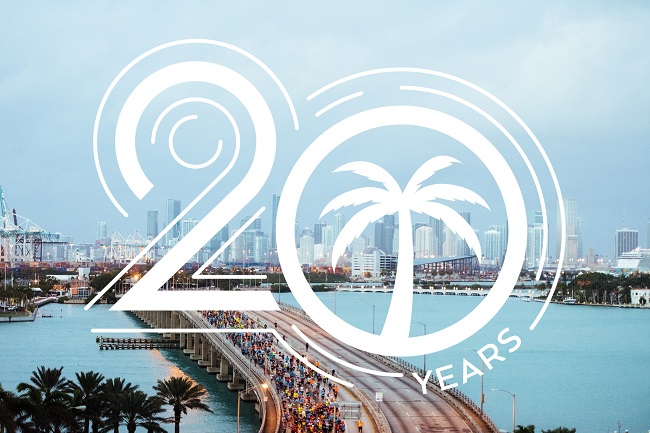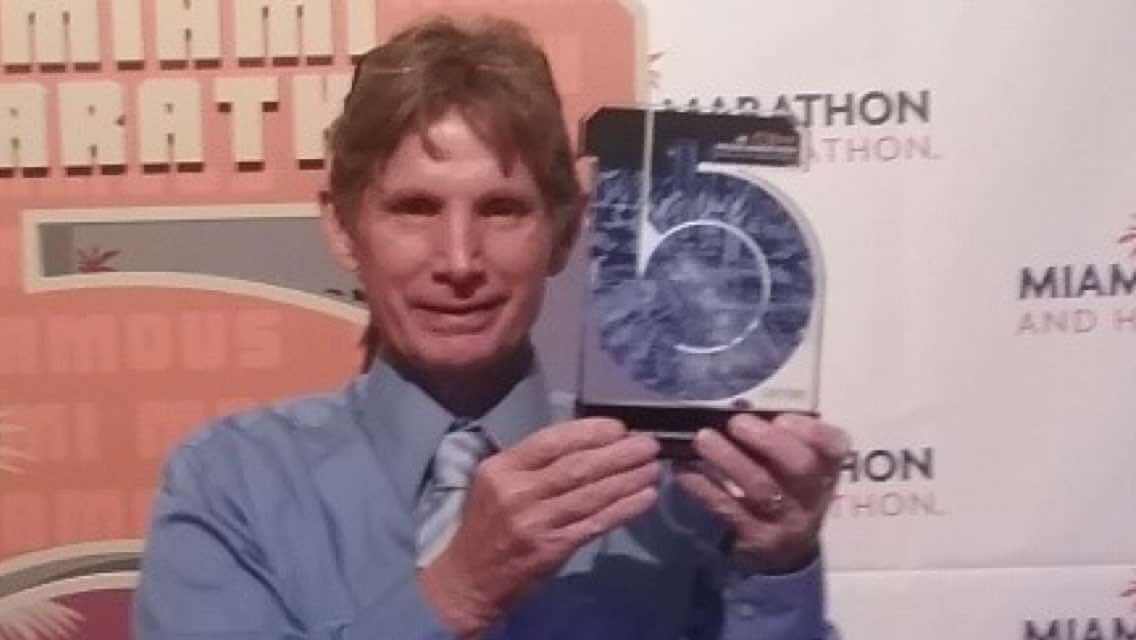Welcome to RACE WEEK! Make sure you know the ins and outs of race…

How To Race-Cation
One of the most amazing parts of participating in an endurance athletic event is the ability to see the city in ways even many of the locals don’t experience.
The popularity of taking a “race-cation” can be seen at the Life Time Miami Marathon & Half Marathon with the over 20,000 participants hailing from all 50 U.S. states and over 80 countries.
Meet Donyetta Edwards of Atlanta, and three others who have all taken race-cations to different destinations in this article featured in Experience Life online: How to Take a Race-Cation.
Article by Kara Douglas Thom | December 2019
Sports travel lets you combine your favorite fitness passion with the opportunity to explore new places.
Not all race vacations are held in traditional hot spots. Take Hayward, Wis., for example. In February — when most people tend to seek respite nearer the equator — some 40,000 skiers and spectators flock to this small town for the largest cross-country-ski race in North America.
Since its debut in 1973, the American Birkebeiner has become to cross-country skiers what the Boston Marathon is to runners. The signature 50K skate and 55K classic races, referred to as “the Birkie,” are part of a weeklong Nordic ski festival that draws skiers from 49 states and 22 countries.
One such competitor is San Francisco Bay Area native Leslie Rogers, 29, who learned to cross-country ski as a child on family trips to Lake Tahoe. “I’d always enjoyed skiing, but it was just a casual once-a-year pastime until I joined Aloha Nordic,” she explains.
This local ski club gave Rogers opportunities to take lessons and travel to races, which included the Birkie skate contest in 2018 and 2019. “If we were going out of our comfort zone by signing up for a 50K, why not go big and sign up for the biggest race in the country?”
Racing in this iconic Midwestern event, Rogers explains, is nothing like recreational skiing in California. “It’s a night-and-day difference to experience a giant race with thousands of people, spectators along the whole course, and an entire town that actually knows what cross-country skiing is,” she says.
While there, Rogers stepped out of her bindings to live like a local. She went dancing at the Sawmill Saloon, dined on cheese curds, and ate fish her host had pulled from a hole in a frozen lake.
“Everyone is so warm and welcoming,” she remembers. “It feels like the entire town contributes to the experience.”
A Winning Trip
Diane Travis, 65, takes a “race-cation” every year. An elite athlete from Clermont, Fla., she’s ticked off championship races while seeing the world.
“I got hooked on duathlons in the mid-1990s and competed in my first world championship in Germany in 1998,” she recalls.
She’s competed in a duathlon national and world championship race almost every year since, while bonding with other athletes who also make the annual pilgrimage. “There’s a reunion feel to it,” Travis says. “As we get older, what keeps us going back is seeing our friends.”
After crossing the finish line, they tack on something fun. In 2019, after racing in Pontevedra, Spain, the group took a five-day bike trip down the coast to Portugal. Four years earlier, following a race in Adelaide, Australia, they went to the Great Barrier Reef for diving and snorkeling, and watched kangaroos on the mainland.
When traveling in the States, Travis makes her own arrangements, but she uses the Chicago-based athlete-focused travel company Premium Plus Sports for international trips. Owner Deepak Patel works out details that might fluster an already nervous athlete in a foreign country, such as finding transportation to and from the airport that accommodates a big bike case or making dinner reservations the night before a big race.
“In Europe, nobody likes to eat before 9 p.m.,” Travis says. “Deepak finds restaurants that will open early and serve the kind of food we need prerace.”
Patel notes that not all athletes choose destinations based on qualifying races. In fact, most of his clients want to race in a specific destination. “The vacation part has taken priority over the race,” he says.
Many racers are simply excited to represent their country while competing against the best in the world.
Travis, however, still aims to come out on top. “I’m going there to win, in addition to representing the United States.”
An Untimed Ride
For those who like the idea of participating in an event but aren’t keen about competition, the Farm to Fork Fondo combines cycling, sightseeing, and a unique foodie experience. The organized ride, with a mass start, has four distances to choose from — from less than 10 miles to more than 90 — in seven bucolic locations in the northeastern, mid-Atlantic, and southern United States.
This appealed to Jen Murphy, 39, from Boulder, Colo., who has made multiple trips to experience the Farm to Fork Fondo with travel buddies of various abilities. “My friend Phoebe has only ridden a bike a handful of times in her adult life. My mom and I are both recreational riders but love fitness. And my uncle trains for long rides and races. The fact that we could all participate because there were different distances to choose from was a big draw.”
The event includes a pre- or postrace dinner, and rest stops at farms along the route offer chef-prepared bites. “I loved the idea of getting to connect with local farmers and be fueled by delicious food rather than just GU and PowerBars,” she says.
Murphy, who packs her helmet but rents a bike at her destination, likes to arrive a day early to try out her cycle and scout the course. Because the event is held in small towns, she also books dinner reservations in advance.
And she always sets up a postevent excursion, which has included a ride on a lobster boat in Maine and hiking in the Berkshires.
“My mom and I want to do all of the Farm to Fork rides,” Murphy says. “This was the first organized event we’ve traveled for, and Farm to Fork makes it so easy with their suggestions on where to stay and what to do in town.”
The Long-Distance Getaway
Donyetta Edwards, 38, of Atlanta, travels often for work and pleasure. Since taking up running in 2009, she has included race adventures in the mix. They’ve taken her to Charlotte, N.C.; Brooklyn, N.Y.; Birmingham, Ala.; Orlando, Fla.; and Savannah, Ga.
Edwards booked a trip to run the Life Time Miami Half Marathon in 2018, partly because she loves the city, but also to cure her FOMO (fear of missing out). “I’ve always loved seeing the posts and reading recaps my other running friends shared about the race,” she says. “Part of the appeal was everyone mentioning how awesome the course is.”
The bling, she adds, was another draw. “The medal always has a great design — it’s beautiful and spins!”
She was in good company. More than 20,000 people, representing all 50 states and more than 80 countries, run the marathon and half-marathon events. Edwards registered for both the 5K (which took place the day before) and the half marathon. “The expo was in the perfect location because I was able to tour Wynwood Walls [a graffiti art walk] and take photos in front of the colorful street murals.”
Edwards also took time to meet up with friends from Black Greek Running Nation, a group of runners who are members of the nine historically black, international Greek-lettered sororities and fraternities. “I got a chance to meet people who, although we are connected on social media through our love of running, I had never met in person,” she says.
But she had to be vigilant about prerace fun. “Vacation is a time I usually spend celebrating, so I had to be mindful not to stay up too late or indulge in too many dirty martinis.”
She also paid special attention to the weather. Knowing there was a chance of rain on both days, she packed two pairs of running shoes. Her foresight paid off. “It rained during the 5K on Saturday, and those shoes were still wet for the half-marathon the next day.”



